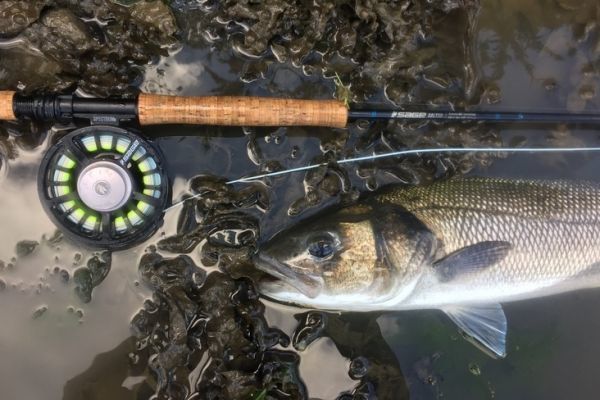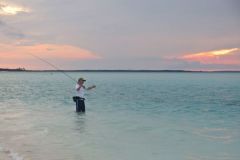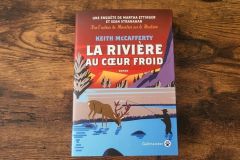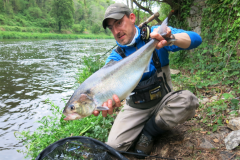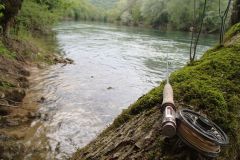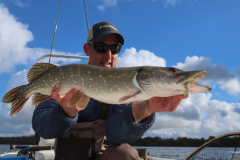I've been sight-fishing for sea bass in estuaries since the course of 2015. I love surveying different estuaries to change my playground and find new spots.
Each estuary has its own specificities in terms of both profile and type of position, which is very interesting for the bass fly fisherman. It's been a few years since I've been back to this estuary, as in my sector of Southern Brittany I'm spoilt for choice. But conditions are good and the fish have been active lately. So I decided to do a bit of scouting again, but also to revisit places where I'd already seen a few nice bass but also a lot of mullet.
Sight-seeing spots for bass and mullet fishing
So I consult Google maps to see a border on the upper estuary.
After stopping off at a point that looked interesting, but without success, at least for this session, I continue along the edge heading downstream, following the ebbing tide.
I see a lot of mullets, but still no sea bass!
Then, on another small point, under two mullets, a pretty sea bass looks for crabs under the rock. I send him my imitation, which falls a little short and disappears from my sight. It's well placed, as the bass is below.
The bar still doesn't reappear and after a few seconds, I barely have time to see my line move before the bar comes out. This time, I didn't have the reflex to strike, but maybe I should have! I'll be sorry I didn't, because right afterwards the bass took off like a rocket. Maybe he had taken it and spat it out! I'll never know.
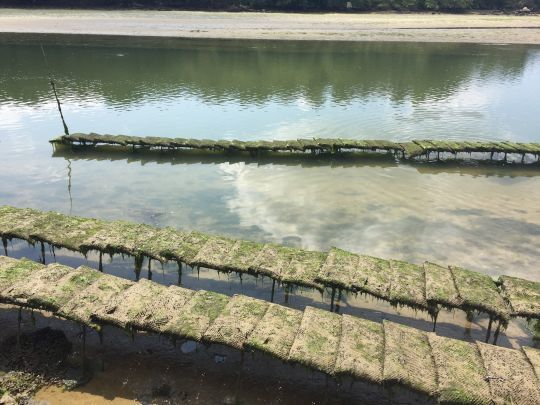
Crab bars
The rest of this rim won't bring me any other opportunities for bass, but it's really well populated with mullet and large specimens that seem to be walleye ( chelon auratus ).
I return to my car, and this time head for a corner where I've seen a few sea bass in the past, but never caught any. They're often under the oyster beds, and not easy to approach or catch.
It's 12:30 and I take my sandwich to eat by the water with the idea of scanning the post at the same time.
No sooner had we arrived than a large sea bass was posted on the edge among the mullets, also of good size, in little water. It's just outside the oyster beds. It moves slowly forward and picks at a crab. He's active. I wait for him to turn, as he's facing me, so I can get down close and cast. I send my green crab imitation 2 meters away, then wait. He moves to the left, then back to the right in the direction of my fly. I don't make any animation, as he seems to have seen it. He moves towards it, then away from it. I animate gently to make him want to come back, and he does. He circles it a little but doesn't pick it up before leaving, frankly! It's a shame. A great opportunity.
I'm still looking here and there between the parks this time.
Under a row of oysters, a small sea bass is hunting in the shrimps. I try to place my fly in his field of vision but he remains well hidden underneath. He doesn't see my imitation. He comes back and hunts again. From the low wall, I set my rod horizontally to cast my fly under the park. It's not an easy cast from my position, but my crab falls 30 cm under the park. The crab must have heard the impact, because it pounces on it. Proper tying. He's at the end, then takes off like a rocket underneath and tries to outwit me. I let him go, as I didn't have much choice, then as soon as the rush was over I bridled him back without leaving him a centimetre of wire and pulled him out of the park. A successful manoeuvre! It's a 42 cm sea bass, just meshed in. Not huge, but sometimes the fishing action is worth more than the size!
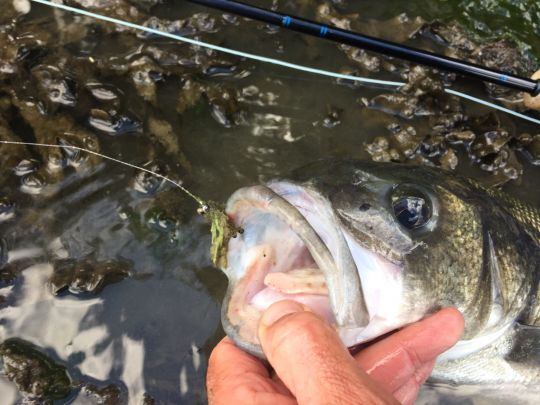
I retrace my steps and see another very nice sea bass (70 cm), also looking for crabs in the small clusters of green algae on the bottom between the rows of oyster tables. He eats one right in front of me, at 7/8 meters. I send out my fly, which lands gently with my line on the park. Not a simple line. He's actively looking for other prey and moving left and right. I try to bring my crab back into his field of vision, then he closes in. I can't see my imitation any more and he comes sucking at something on the bottom. I strike, but he's not on mine. He's just swallowed one right next to my fly! He's been frightened by my fly-tying in the void, and he's off with all flippers blazing.
I then head back into the water to skirt the parks, as the tide is about to come in. Sea bass and mullets love to hang out here, as these structures provide them with food and shelter.
After walking along a whole row, at the end and under the last pocket, a sea bass passes by and shows its sharp head, characteristic of the species, unlike the mullet. No doubt about it, this is one of them. I cast my crossbow so as not to frighten it, but my fly falls too far. He doesn't really come out and also stays below waiting for prey. He hunts in the fry and/or shrimp again. I cast again and let him drop the crab nearby. He comes out slowly, examines it then sucks it in between two waters. I hook and put a lot of pressure on him, pulling him to the left to get him out from under there.
He gives in and then heads for the estuary bed. Once the rush is over, I fight it hard to keep it from returning to the tables, otherwise it's guaranteed to break. It's a nice fish, just under 50 cm. Another great action.
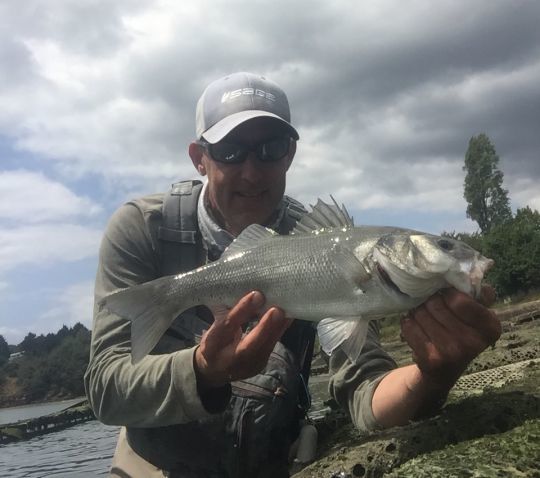
Mule double on a mudflat
I'm still wandering between the parks, but the water level has already risen and I won't be able to see them any more, as the water is full of algae and sediment. I decide to go and see the mullets, as there really are a lot of them, and not far away a beautiful mudflat would be ideal for fishing.
Mullet are a rather complicated species to catch. On flies, with small imitations of mud and sand fleas and size 12 worms, you can get them to bite when they're in very little water. So I tie two flies. A shrimp tippet and a mullet bach gallows.
The idea is to bring the flies to the bottom, where the most mullets are.
After a spot where they are numerous, without any success, I move to a small cove where the bottom is not too heavy with seaweed, otherwise every time I cast, the flies are covered with it!
After a few minutes, the first mullet strikes my flies, but it doesn't bite! I insist a little, because they're there and very active. You can see them open their mouths and scrape the bottom. They come in small groups of 4/5 and go back and forth.
Then suddenly the leader became taut. This time he's caught well. In a little water, the fight isn't too violent but he still pulls a bit. I take him back to the bank. He's taken the gallows fly, which is often the one they prefer.
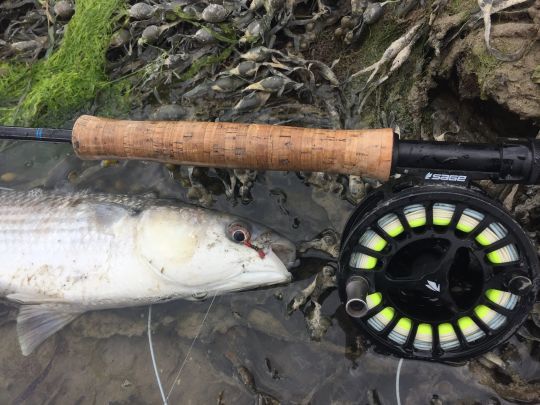
The activity calms down, but from time to time a few golden mullets come right up to the edge to follow the flow and the tide as it rises in the cove. Another golden mullet, over 50 cm long, also comes to take the "mullet bach". This time, with more water, he gave me a few little rushes, but he too came into my hands for a few photos!
A great session with a double of bass and a double of mullet! It's not every day!
Summer is a busy time for tourists, but if you look hard enough, you'll find a few less crowded, quieter spots where the fish have a field day!
